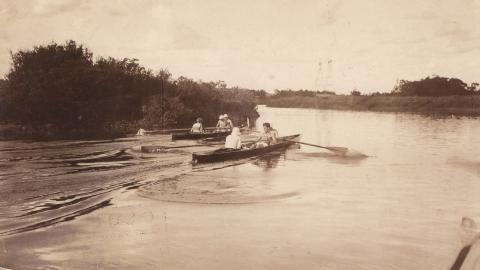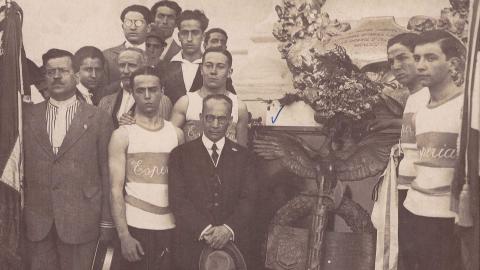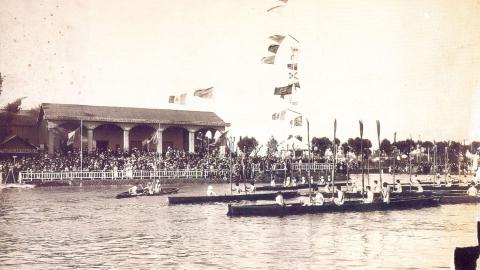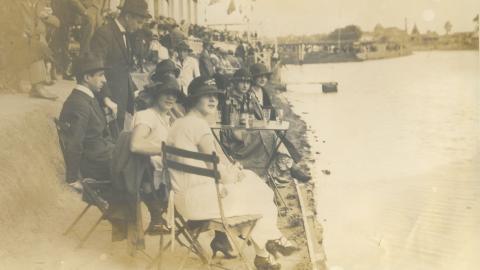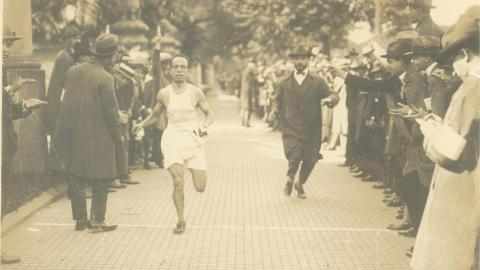Clube Esperia
Clube Esperia was founded on the 1st of November 1899, by a group of seven young Italians who frequented the Ponte Grande district, north of São Paulo. They were Emilio Gallina, Pietro Lazzarone, Luigi Torre, Emilio Tallone, Angelo Quaranta, Fulvio Constanzo and Ercole Ervvenn used to meet in a traditional cake shop called “Accasto & Lazzarone”.
At the end of the 19th century, Ponte Grande was a place where people went to enjoy themselves, with several restaurants and picnic spots. These included “Recreio Bella Venezia”, a favourite with the Italian community, which offered trips on rented boats on the then clear and placid waters of the Tietê, set amidst the beauty of large forests, on Saturdays and Sundays.
It was at the “Accasto & Lazzarone” cake shop that the seven young rowers talked about and decided to form a rowing club, a sport that was much more popular than football at the time. Several names were proposed: “Club Canottieri Cerea”, “Club Canottieri Tietê” and, last but not least, “Club Canottieri Esperia”, and the latter won.
Clube's first facilities were built in “Chácara da Floresta”, on the left bank of the Tietê, opposite the current premises. In 1903 they moved Clube to the other bank, where it still stands today. The new Club Headquarters was inaugurated on the 2nd of October 1904, under the administration of Chairman Menotti Falchi. With the relocation of Clube from Chácara Floresta to the new premises, Clube Esperia saw a considerable increase in its membership. The new premises had spaces for playing tamburello, shooting, swimming, athletics and many other activities.
In the 1920s and 30s, Clube became champions several times in disciplines such as basketball, volleyball and water polo, even sending athletes to the Olympics. In 1937, Clube received the title of “A mais completa agremiação esportiva do Brasil”, the most complete sports association in Brazil.
On the 21st of September 1942, during the Second World War, a law requiring all organisations of foreign origin in countries involved in the war and against, which Brazil was fighting, to nationalise their names was enacted. And so Clube became “Associação Desportiva Floresta”, with reference to Clube's first location in “Chácara Floresta”. Twenty-three years later, in 1965, following a movement launched by the members, the Club was called Esperia once again, this time “Clube Esperia”, a name made official during a lunch offered by the sporting chronicle of the time.
The 1960s were a decade of great transformation, and social events, parties, celebrations of Italian traditions and musical events began to be held at the Sports Hall.
In 1977, the Esperia Women's Social Commission was established. Created by the wives of the Clube directors, their aim was to organise the most varied events, from bazaars to charity campaigns, staff parties and International Women's Day.
They inaugurated the new Club Headquarters in the early 1980s. There, the events, social life and agreements became even more active.
The Social Department was renewed during the 1990s and 2000s, maintaining the more traditional events and offering its members moments of inclusion and recreation, with events such as Arabian Night and Italian Night.
In 2010, Clube Esperia launched the project “The Olympic dream returns to Esperia” with the clear aim of recovering Esperia's tradition as a club that trains great athletes and as a sporting power in the country.
In 2015, Clube Esperia implemented a project to train Paralympic athletes, and today the following Paralympic sports boast an Esperia representative: athletics, archery and swimming, as well as wheelchair basketball and tennis.
Story compiled thanks to Romina Deprati, Gina Marques and Andrea Pedemonte in collaboration with Archivio Storico del Club Esperia.
-
SportItalia, ITSan Paolo del Brasile, BRDal 1861 al 1900
Timeline
-
1899
Clube Esperia was founded on the 1st of November 1899, by a group of seven young Italians who frequented the Ponte Grande district, north of São Paulo.
-
1904
The new Club Headquarters was inaugurated on the 2nd of October, under the administration of Chairman Menotti Falchi.
-
1937
In the 1920s and 30s, Clube became champions several times in disciplines such as basketball, volleyball and water polo, even sending athletes to the Olympics. In 1937, Clube received the title of “A mais completa agremiação esportiva do Brasil”.
-
1942
During the Second World War, a law requiring all organisations of foreign origin in countries involved in the war and against, which Brazil was fighting, to nationalise their names was enacted. And so Clube became “Associação Desportiva Floresta”.
-
1965
The Club was called Esperia once again, this time “Clube Esperia”.
-
2010
Clube Esperia launched the project “The Olympic dream returns to Esperia”, in 2015, Clube Esperia implemented a project to train Paralympic athletes.

